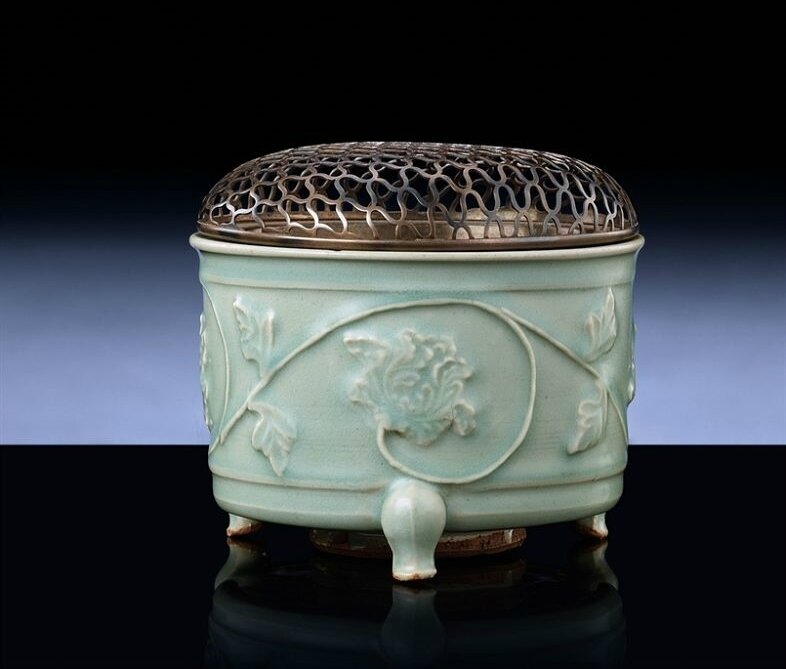The deep upright sides raised on three cabriole legs and decorated around the sides in relief with a continuous lotus scroll bearing four blossoms on the leafy, tendril-like stem, the exterior covered with a glaze of sea-green tone that continues over the legs and underside to the circular foot ring in the centre, and over the flat mouth rim and down the sides of the interior, the bottom of the interior unglazed and painted in black with an indecipherable character, reticulated silver metal cover, Japanese wood boxes.
Provenance: Baron Kondo Renpei (1848-1921), Japan
Exhibited: National Museum of Japanese History, Culural History of Ceramic Ware, 24 March 1998 - 5 May 1998, Sakura City, Chiba Prefecture, Japan and illustrated in the Catalogue, no. 31
Note: Baron Kondo Renpei was one of the founders of the Mitsubishi Group, president of Nippon Yusen Kaisha (NYK Line) and Kirin Brewery Co. Ltd. 1837-1927. He was awarded the title of Baron by Emperor Meiji in 1911 in recognition of his distiguished services to the development of the marine transportation trade in Japan. His wife was from the Matsudaira family, related to the tea master and daimyo of the Matsue domain, Matsudaira Fumai.
Censers of this type were made during the Southern Song and Yuan dynasties. Examples have been found in a Song stratum at Quanzhou in Fujian province, which at the time was the main port for overseas trade. A piece from a Yuan tomb, also at Quanzhou, is illustrated in Longquan Qinci, Beijing, 1966, pl. 23 bottom, and another larger example from the Shanghai Museum is illustrated ibid., pl. 50. Other published examples include one in the Idemitsu Museum of Arts illustrated in Song Dynasty Ceramics, Tokyo, 1979, pl. 19, which is quite similar in shape, but of smaller size; one of similar size and shape in the Asian Art Museum, San Francisco, illustrated by He Li, Chinese Ceramics, New York, 1996, p. 158, no. 271, dated Southern Song dynasty; a slightly smaller example illustrated by R. Krahl, Chinese Ceramics in the Meiyintang Collection, vol. 1, London, 2001, p. 303, pl. 568, dated Southern Song or Yuan dynasty. Others are in the Museum of Fine Arts, Boston; the Hakutsuru Art Museum, Japan; the Ardebil Shrine; and the Toyko National Musuem.
Christie's. The Imperial Sale Important Chinese Ceramics and Works of Art, 31 May 2010, Hong Kong

/https%3A%2F%2Fprofilepics.canalblog.com%2Fprofilepics%2F1%2F0%2F100183.jpg)
/https%3A%2F%2Fstorage.canalblog.com%2F03%2F02%2F119589%2F96711876_o.jpg)
/https%3A%2F%2Fstorage.canalblog.com%2F11%2F31%2F119589%2F94773502_o.jpg)
/https%3A%2F%2Fstorage.canalblog.com%2F20%2F83%2F119589%2F94772815_o.jpg)
/https%3A%2F%2Fstorage.canalblog.com%2F26%2F72%2F119589%2F75604929_o.jpg)
/https%3A%2F%2Fstorage.canalblog.com%2F59%2F60%2F119589%2F26458628_o.jpg)



/image%2F1371349%2F20240327%2Fob_dcc73a_2024-nyr-22642-0840-001-a-dehua-tripod.jpg)
/http%3A%2F%2Fstorage.canalblog.com%2F01%2F16%2F119589%2F129639878_o.jpg)
/http%3A%2F%2Fstorage.canalblog.com%2F99%2F65%2F119589%2F129559829_o.jpg)
/http%3A%2F%2Fstorage.canalblog.com%2F04%2F79%2F119589%2F129360980_o.jpg)